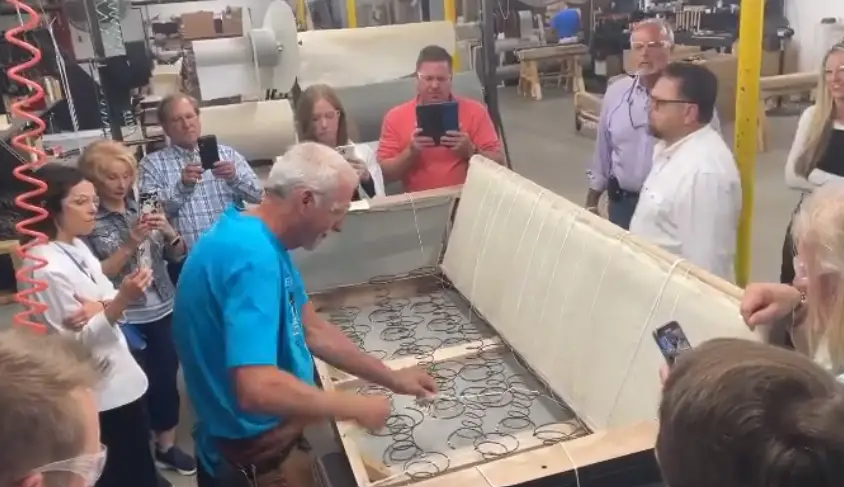If you're on the market for a new sofa, you might have come across 8-way hand-tied suspension systems in your research. If you are wondering what this means in terms of buying new furniture, we are here to break it all down.
It is important to note that furniture manufacturers use different techniques to build suspension systems for different types of sofas and an 8-way hand-tied suspension system is one of them.
To note, the suspension system in a sofa is the inner support system to your furniture. It sits right below the cushions and provides the support for your couch. Without it, you would fall right into the frame of your couch.
An 8-way hand-tied suspension system is the gold standard in the furniture industry, but it is also the most expensive. With an 8-way hand-tied suspension system, a series of springs or heavy-gauge coils are arranged on the base of the sofa (beneath the cushions). These coils are then fastened to the frame and other coils using twine that runs in eight directions.
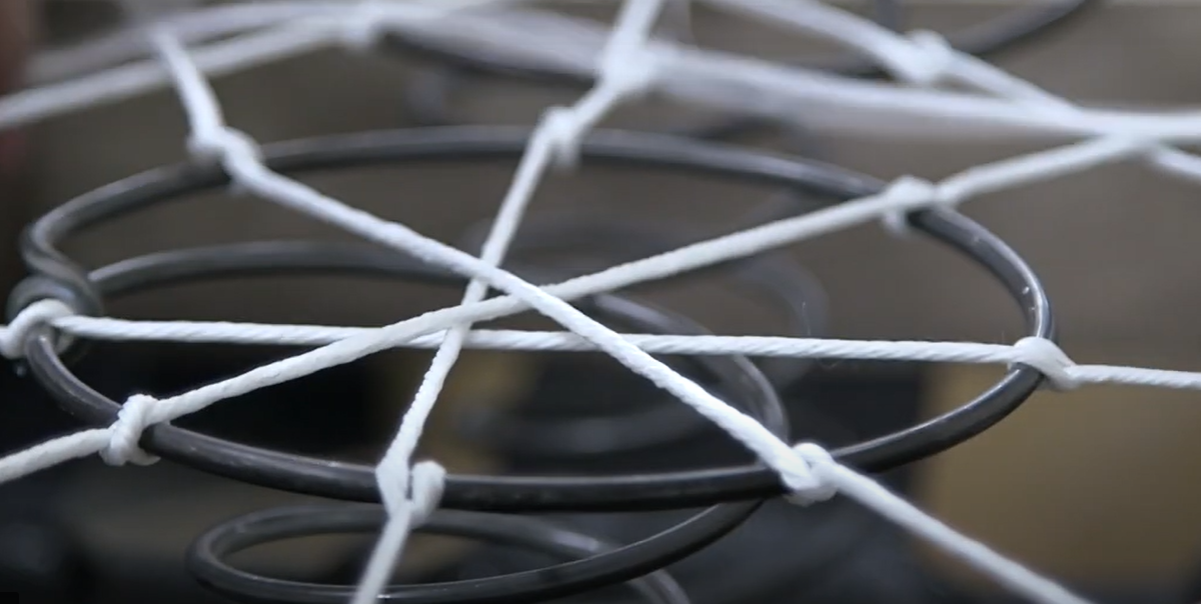
This means each spring (or coil) is fastened from eight directions, producing a comfortable, durable sofa when everything is done the correct way.
The purpose of tying the springs together with twine in eight directions and onto the furniture frame is simply to keep the strings locked in place and to keep them from shifting.
This stability and attention to detail provide unwavering support for years.
See our guide to high quality sofa construction for more details on 8-way hand tied versus other suspension systems like drop in coils, sinuous springs, and webbing.

Example of a traditional 8-way hand tied sofa.

A Leggett & Platt Drop In 8 Way Hand Tied System

The most common suspension system uses sinuous wire.

Example of webbing suspension with furniture
Brief History Of the 8-Way Hand-Tied Suspension System
A brief history of these types of sofas dates back to the 1850s. During that time, furniture makers sought to build new sofas that provided better comfort and durability.
Cushions on sofas were made up of low quality materials like feathers, cotton, or horse hair and were thinner compared to what is available today. Due to that fact, craftspeople made strong foundations underneath the sofa to make them comfortable and strong.
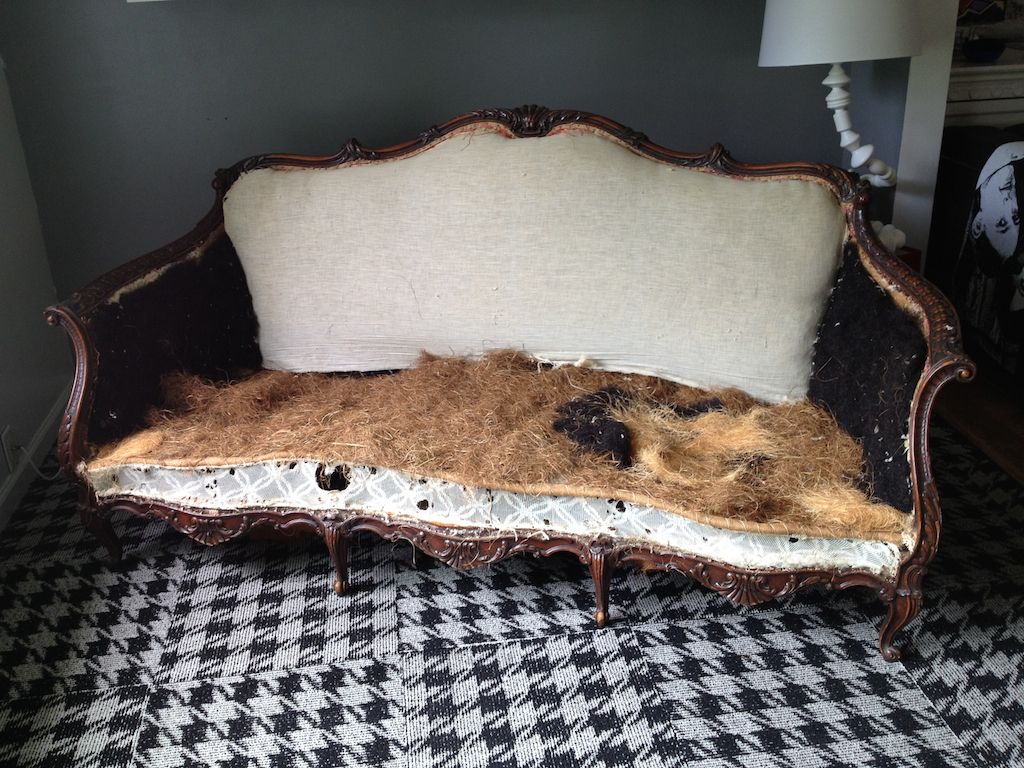
Vintage Sofa filled With Horse Hair
One important innovation at the time was the use of individual coil springs as a part of the suspension system. Furniture makers started to utilize a technique which placed the coils in a grid like system, while hand-tying the coils to each other in different directions.
This is well described in the book, "The Art of Spring Stuffing," by John Seville Crofton in 1834 and became the start of the infamous 8-way hand tied suspension system.
Why Is An 8-Way Hand-Tied Suspension System the Best Choice for Your New Sofa?
Undoubtedly, an 8-way hand-tied suspension is the best choice for a new sofa than most other techniques. This is because of the following reasons:
Durability
When done by a skilled craftsman, the 8-way hand-tied suspension in a sofa can last for over 20 years. It takes time to arrange the springs and to weave them from side to side, diagonally, and from front to back. The tying is also fastened to the frame, making the coils unmovable and strong.
This video below from Century Furniture shows one of their skilled crafstmen undergoing the meticulous process of tying the coils together and to the frame. This is a labor intense process and it does a number on the fingers! This is why it is becoming harder and harder to find workers that want to do this for a living.
Comfort
There has been great debate about the actual benefits and comfort advantags to an 8-way hand tied system, ever since Consumer Reports came out in 2005 saying that it wasn't worth all the hype:
“Disregard the term ‘eight-way hand-tied springs.’ It’s no longer synonymous with comfort or high quality. Other types of springs — coil, cone, S-shaped, and grid — can be just fine; they mainly influence how comfortable the sofa feels to you.”
I would tend to agree that other alternatives have come a long way, especially drop-in coil spring systems, which try to replicate the benefits of a manual 8-way hand tied system using technology and manfacturing advancements. And thus for many consumers, there is not going to be a noticeable difference in a furniture showroom between varying suspension systems.

An eight way hand tied suspension system at Classic Leather (source Youtube)
But there is something to be said for buying furniture made with someone's bare hands. One with a time-tested process that has led to excellent results over the years. Let's face it - a company that takes the time and effort to build furniture using an 8-way-hand-tied process is not cutting any corners.
In my opinion, an 8-way hand tied sofa will offer greater flexibility and support than other sofa suspension systems. It has also proven to help prevent sagging, making the couch comfortable throughout, unlike other inferior suspension systems that can sag when you sit on them for too long.
No Metal-Metal Touch
Twine is used to tie the springs together and to the frame. Of course, different types of twines are available for upholstery, but when you get the best twines with high tension, it works perfectly.
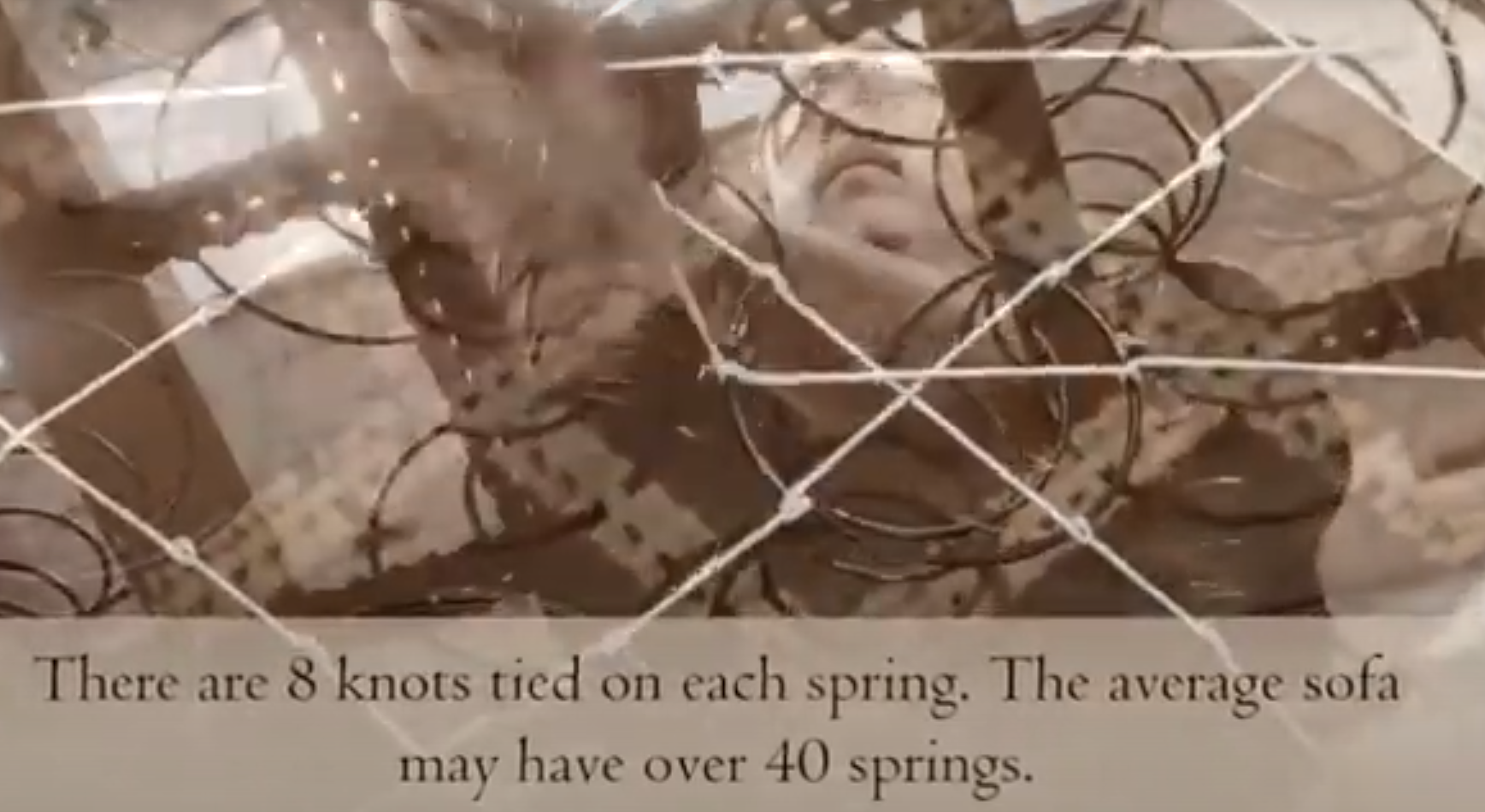
The Italian Ruby Twine for furniture upholstery is one of the options that has been praised for quality. It is made with 4-ply hemp and with a wax finish to make tying easy and is often used by high quality furniture manufacturers.
Using twine when tying the strings together will provide a no metal-metal touch; hence there will be no squeaking. That means your sofa will always remain silent as you sit down.
The downside of using twine is that it can break, but the good news is that repairs are easy, as the repairs only need to consider a replacement of the twine and not the actual coil springs.
Some furniture makers might use wire instead of twine, which can be used since it does not break, but it is easy to hear the squeaking, which lessens the sofa's quality. If you sit on a couch and all you hear is squeaking, I'd probably move to the next sofa!
Weight And Pressure Distribution
Another critical aspect of the 8-way hand-tied suspension in sofas is that it helps distribute the weight evenly across the frame. When this is the case, there are fewer weak points on the base of the couch, leading to improved performance with time.
The other good side of this technique is that it helps to reduce the pressure that would otherwise be exerted on the frames. This makes the sofas always look upright since the frames do not bow or warp.
Durable Springs
The springs or coils that are used in the process of making an eight-way suspension system in the sofas last a lifetime. Therefore, whenever you need to reupholster your sofa, you only need a skilled craftsperson to retie them and get your sofa back to its original quality without the need to buy new coils.
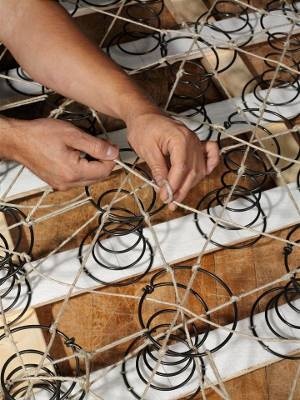
8 Way Hand Tied Springs Source Wiki Commons
8-Way Hand-Tied Sofas Vs. Sinuous Spring
Most people looking for high-quality and durable sofas compare the eight-way hand-tied sofas to the sinuous spring sofas. Of course, the two differ regarding the materials used and how they are made.
With the 8-way hand-tied sofas as I have described, the springs are tied to each other and the frame in eight different directions. This yields a comfortable, high-quality sofa that can last years without sagging.
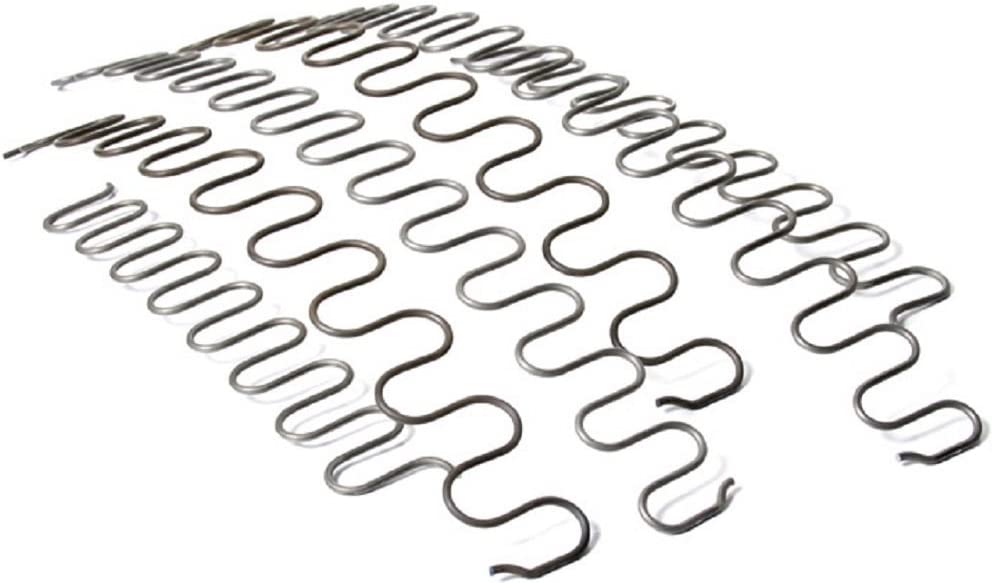
Sinuous Springs, An Inferior CHoice to 8-Way Hand Tied
On the other hand, sinuous spring sofas are the most common suspension systems in low to mid-range priced sofas. They are made using an S-shaped spring, or thick-gauge wire bent to create a recurring S-shaped pattern.
The disadvantage of a sinuous spring is that it can fail since a lot of weight lies in a small portion of the whole system. In addition, the clips used to attach the spring to the frame can also fail, and when this happens, the seat will sink or sag.
With this comparison, I prefer to go with eithe an 8-way hand tied system or even a drop in coil system if you are looking for a sofa at a bit of a lower price.
Downsides of 8-Way Hand-Tied Suspension Systems
An 8-way hand tied sofa may sound luxurious, comfortable, perfect, flexible, durable, and classy but it also has its downsides that include the following:
Labor-Intensive and Expensive
Quality comes with a price. The time it takes to arrange and weave the springs requires skill and time. To achieve 8-ways tied from side to side to each spring and onto the frame is labor intensive and can take a lot of time to accomplish.
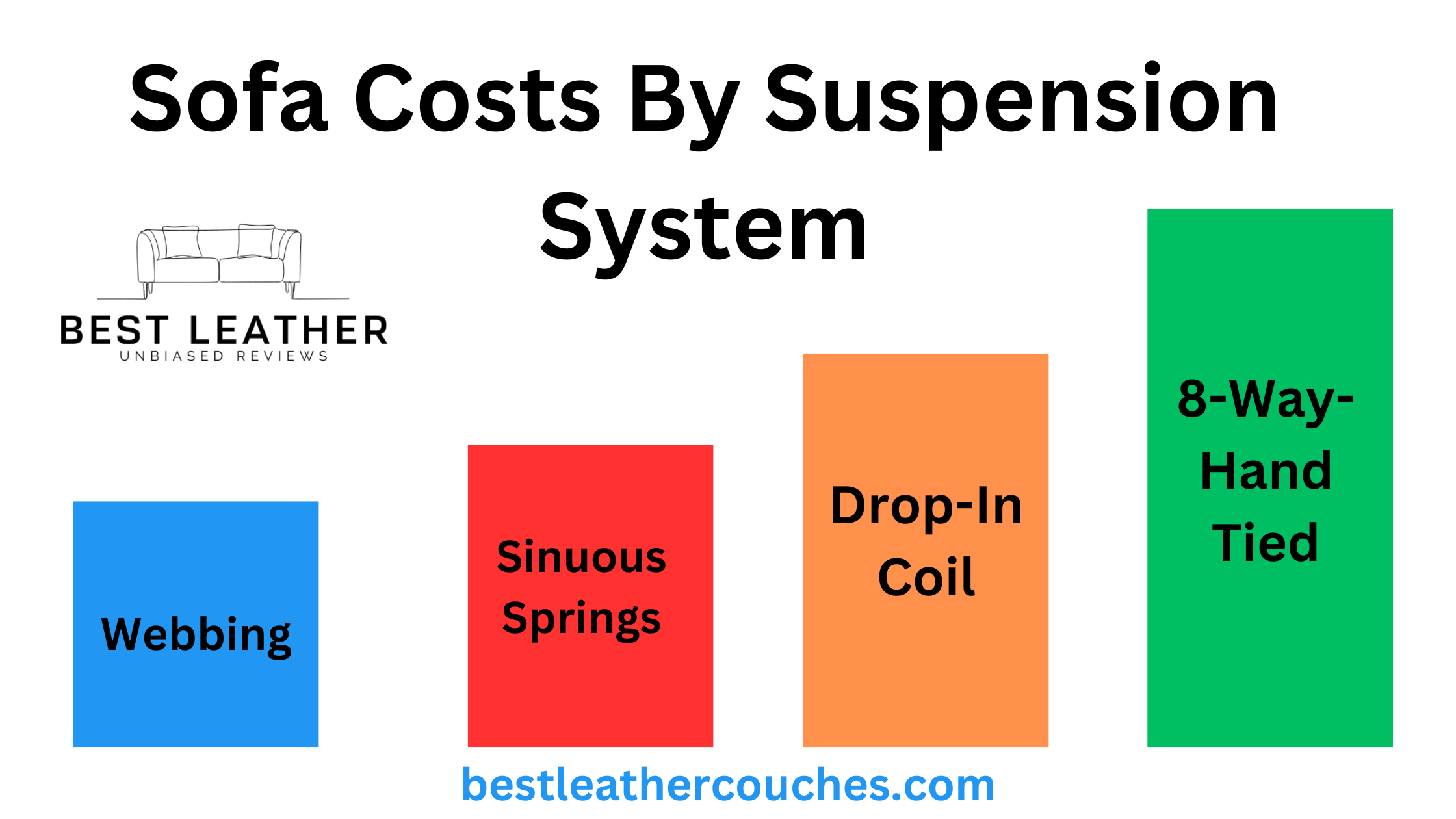
This, however, results in a high-quality sofa that is soft, comfortable, durable, and flexible but can be a bit expensive compared to those made using other simple techniques.
Requires Great Skills In Craftsmanship
Tying each point of the springs until eight hand-tied connections are achieved for each spring requires excellent attention to detail and skill to avoid potential failure points.
In this case, if you fail in one spring, the next spring can suffer the pressure since it has to bear the load. Finding skilled craftspeople in this niche is difficult.
Some have even speculated that this method of craftsmanship could ultimately disappear due to the lack of quality workers.
Requires good quality twine
Finding a good quality twine that is durable and with high tenacity can be challenging. This is because several options and brands out there claim to be the best. It thus takes time to research and find a reliable, durable, and high-quality twine.
When a lower-quality twine is used, the suspension system can start to fail, lowering the sofa's quality. Compared with the clips used in sinuous springs, twine is much better since a break of the string or twine can make no significant impact compared to a failed clip.
Difficulty In Differentiating
While thinking of these hand-tied spring sofas, it is essential to note that some manufacturers currently produce the "drop-in" 8-way hand-tied units in masses, and it may seem difficult to tell the difference.
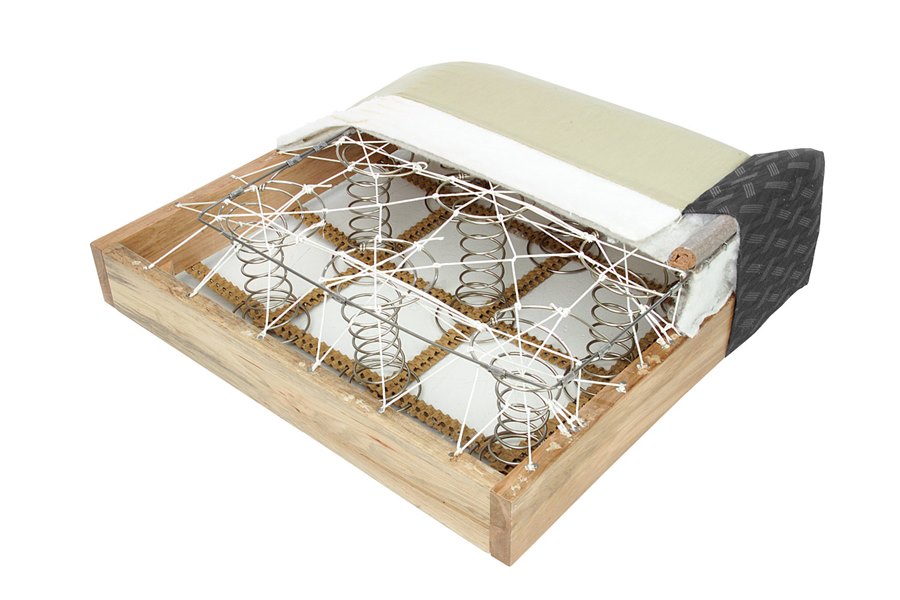
A Leggett & Platt Drop In 8 Way Hand Tied System
Even an expert may find it difficult to tell what material has been used beneath the seat deck since they are all comfortable when they are still new. Therefore, it is important to sample genuine manufacturers with skilled craftspeople who take the time to build custom sofas by hand.
That's not to say that a drop in coil system can't be a good choice for your next sofa purchase, but be sure that you aren't paying expert 8-way-hand tied prices for a sofa that is using a drop in coil spring system. Many furniture companies will call a sofa '8-way hand tied' even though it is still just using a 3rd party drop in spring system.
Is An 8-Way Hand-Tied Leather Sofa Worth It?
An 8-way hand-tied suspension system is considered the gold standard in furniture construction, and pieces with this support system are typically more expensive than those with other suspension systems. However, they are also typically of higher quality and designed to last many years with proper care.
This technique has long been used to make high-quality, comfortable, long-lasting sofas. And thus, I consider any high-quality 8-way hand-tied suspension system the gold standard in choosing a new sofa.
Of course, any 8-way hand tied sofa is going to be priced at a premium, thus for consumers looking to save a bit of money, I do think that a drop-in coil system is a good alternative.
Are you looking at a new sofa with an 8-way hand-tied suspension system? Or do you have a good or bad experience with a piece or style of furniture that uses an 8-way hand-tied system?
Feel free to leave a comment below.

